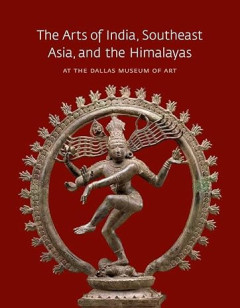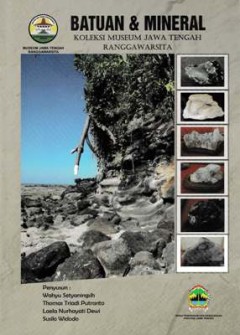Ditapis dengan
E-book A History of Museology
Is museology a theory or a set of practices? Is it a science or just museum work? Is it the same as museum theory? Or is it autonomous from the museum? Is it a philosophy or is it based on social experimentation? Are we evolving towards the path of a metamuseology? If so, what are the boundaries of this ‘museology’ that has shown to have no boundaries in the past decades of theoretical rese…
- Edisi
- -
- ISBN/ISSN
- 9789290124566
- Deskripsi Fisik
- 232 hlm
- Judul Seri
- -
- No. Panggil
- 069 CHU a
E-book Key Concepts of Museology
What is a museum? How do we defi ne a collection? What is an institution? What does the term ‘heritage’ encompass? Museum professionals have inevitably developed answers to questions such as these, which are fundamental to their work, compiled according to their knowledge and experience. Do we need to reconsider these? We believe so. Museum work shifts back and forth between practice and th…
- Edisi
- -
- ISBN/ISSN
- 9782200253981
- Deskripsi Fisik
- 90 hlm
- Judul Seri
- -
- No. Panggil
- 069 DES k
E-book Working Through Colonial Collections
his research was funded by the Alexander von Humboldt Foundation as part of the research award for Sharon Macdonald’s Alexander von Humboldt Professorship, and was carried out at the Centre for Anthropological Research on Museums and Heritage (CARMAH) at the Department for European Ethnology, Humboldt-Universität zu Berlin. I also received financial support from the Ge…
- Edisi
- -
- ISBN/ISSN
- 9789461664242
- Deskripsi Fisik
- 320 hlm
- Judul Seri
- -
- No. Panggil
- 069 VON w
E-book Virtual Museums – A Plea : Around the Clock, Around the World
igitalisation and virtual worlds are increasingly permeating the cultural sector and the creative industries. When it is difficult for cultural offerings to find their audience, they can or must actively reach out to their audience. This also applies to museums, which can find and retain audiences in different ways and with different formats. Even a virtual museum is fundamentally a museum. …
- Edisi
- -
- ISBN/ISSN
- 9783422802377
- Deskripsi Fisik
- 103 hlm
- Judul Seri
- -
- No. Panggil
- 708 VIR v
E-book The Museum Accessibility Spectrum : Re-imagining Access and Inclusion
Central to the practice of the modern museum sector are the principles of access, inclusion, diversity, sustainability, and community participation (ICOM, 2022). As the curators of our cultural and social histories, the heritage sector is morally and legally required to provide reasonable adjustments to ensure equitable access or all people. The dictionary definition of access is the me…
- Edisi
- -
- ISBN/ISSN
- 9781003382713
- Deskripsi Fisik
- 313 hlm
- Judul Seri
- -
- No. Panggil
- 069 EAR t
E-book The Aftermaths of Participation
It has been seven years since the so-called refugee crisis in Europe, andwarfarecontinuestoforcepeopletoleavetheirhomelandstosettleelsewhere.AsIamwritingthis,inAprilof2022,RussiantroopsaretearingapartUkraineand the lives of its people, forcing many people to flee their homes. Forcedmigration is not temporary phenomenon, and historical, ethnographic andcity museums will –one wayor another –c…
- Edisi
- -
- ISBN/ISSN
- 9783839464113
- Deskripsi Fisik
- 273 hlm
- Judul Seri
- -
- No. Panggil
- 069 BOE t

E-book The Arts of India, Southeast Asia, and the Himalayas at the Dallas Mus…
In recent years, the Dallas Museum of Art has expanded its collection of South Asian art from a small number of Indian temple sculptures to nearly 500 works, including Indian Hindu and Buddhist sculptures, Himalayan Buddhist bronze sculptures and ritual objects, artwork from Southeast Asia, and decorative arts from India’s Mughal period. Artworks in the collection have origins from the former…
- Edisi
- -
- ISBN/ISSN
- 9780300149883
- Deskripsi Fisik
- Dallas Museum of Art
- Judul Seri
- -
- No. Panggil
- 708 BRO t

E-book The Art of Museum Exhibitions: How Story and Imagination Create Aesthe…
Leslie Bedford, former director of the highly regarded Bank Street College museum leadership program, expands the museum professional’s vision of exhibitions beyond the simple goal of transmitting knowledge to the visitor. Her view of exhibitions as interactive, emotional, embodied, imaginative experiences opens a new vista for those designing them. Using examples both from her own work at th…
- Edisi
- -
- ISBN/ISSN
- 9781611323108
- Deskripsi Fisik
- 168 halaman, ilus.
- Judul Seri
- -
- No. Panggil
- 069.5 BED t
E-book What Photographs Do: The Making and Remaking of Museum Cultures
What are photographs ‘doing’ in museums? Why are some photographs valued and others not? Why are some photographic practices visible and not others? What value systems and hierarchies do they reflect? What Photographs Do explores how museums are defined through their photographic practices. It focuses not on formal collections of photographs as accessioned objects, be they ‘fine art’ or…
- Edisi
- -
- ISBN/ISSN
- 9781800082984
- Deskripsi Fisik
- 357 hlm
- Judul Seri
- -
- No. Panggil
- 069 EDW w
E-book Heritage Dynamics : Understanding and adapting to change in diverse he…
How is heritage created and re- created, shaped and reshaped, formed, reformed and transformed – or even reborn? Heritage in all its forms endures a lengthy and dynamic journey of emergence, transformation, decline and revival. An object displayed within a museum showcase may have travelled through various places and changed uses more than once before acquiri…
- Edisi
- -
- ISBN/ISSN
- 9781787358331
- Deskripsi Fisik
- 255 hlm
- Judul Seri
- -
- No. Panggil
- 069 FOU h
E-book Jamaica Making : The Theresa Roberts Art Collection
his exhibition at the historic Victoria Gallery and Museum, Liverpool, comprises almost entirely of art works in the collection of Theresa Roberts, who is founder and owner of the Jamaica Patty Co. restaurant, based in Covent Garden, London.Theresa Roberts was born in Jamaica to parents who emigrated to the United Kingdom as part of the ‘Windrush Generation’: those who were invited by Briti…
- Edisi
- -
- ISBN/ISSN
- 9781800855472
- Deskripsi Fisik
- 96 hlm
- Judul Seri
- -
- No. Panggil
- 708 ROB j
E-book Heritage Conservation and Social Engagement
Professionals working with cultural heritage preservation have had to respond to difficult challenges in the last few decades, mainly brought about by globalisation, armed conflicts, natural disasters and the use of heritage as an ultimate resource to redress injustices of the past. The topics and experiences discussed in this book demonstrate that conservators may …
- Edisi
- -
- ISBN/ISSN
- 9781787359208
- Deskripsi Fisik
- 199 hlm
- Judul Seri
- -
- No. Panggil
- 069 PET h
E-book Mind Museums : Former Asylums and the Heritage of Mental Health
This book is grounded in the belief that there is a need to talk more about mental health from the perspective of both historical and current issues and practices. This is what Catharine Coleborne, internationally renowned scholar in the field of mad studies and histories of mental health and psychiatry, also maintains in her most recent book Why Talk About Madness (2020). Here, Coleborn…
- Edisi
- -
- ISBN/ISSN
- 9781003258971
- Deskripsi Fisik
- 139 hlm
- Judul Seri
- -
- No. Panggil
- 708 LAN m
E-book Sri Ksetra Museum Collection Inventory
This inventory is the first comprehensive account of objects held by the Sri Ksetra Museum, Hmawza. It is the result of a collaborative project that started in 2014 with Museum and the Field School of Archaeology (FSOA) staff. The aims of the project were to catalogue the Pyu material and develop staff skills in museum methods. At first the goal was to document works on display in the museum, a…
- Edisi
- -
- ISBN/ISSN
- 9783110674064
- Deskripsi Fisik
- 287 hlm
- Judul Seri
- -
- No. Panggil
- 069.3591 GAL s
E-book Making the Palace Machine Work : Mobilizing People, Objects, and Natur…
The Qing, the last dynasty of the Chinese imperium, ruled for over 260 years (1644-1911). At the end of the 19th century it occupied a territory of roughly 13 million square kilometres and claimed sovereignty over more than 400 million people. One of the questions this book examines is how – on a sheer logistical level – was a complex empire of this size governed before the age of telegrams…
- Edisi
- -
- ISBN/ISSN
- 9789048553228
- Deskripsi Fisik
- 335 hlm
- Judul Seri
- -
- No. Panggil
- 069 AKC m
E-book The Museum as Experience : Learning, Connection, and Shared Space
Few visitors to art museums walk in expecting to find thirtyplus middle school students acting as their own docents, leading their peers through discussions of what they see and wonder about in works of art from abstract expressionism to wood turn-ings, to sculptures by Rodin. But for close to ten years, we led seventh and eighth grade students through patterned closeviewing and dialogical …
- Edisi
- -
- ISBN/ISSN
- 9781802701470
- Deskripsi Fisik
- 184 hlm
- Judul Seri
- -
- No. Panggil
- 069 HEI t
E-book Fashion, History, Museums : Inventing the Display of Dress
It has become easy to become complacent about fashion exhibitions in museums. Their sheer number and extravagant scale have drowned out the skeptics who once questioned the place of fashion in the museum. Yearly, and even monthly, news media outlets report lists of the must-see fashion exhibitions worldwide, anticipating the avid interest of their readership. Richl…
- Edisi
- -
- ISBN/ISSN
- 9781350049017
- Deskripsi Fisik
- 257 hlm
- Judul Seri
- -
- No. Panggil
- 708 PET f
E-book Mobile Museums : Collections in Circulation
This book presents an argument for the importance of circulation in the study of museum collections, past and present. Bringing together international researchers from a wide variety of disciplines (including the history of science, museum anthropology, archaeology, geography and postcolonial history) to consider the mobility of collections, we aim to provi…
- Edisi
- -
- ISBN/ISSN
- 9781787355088
- Deskripsi Fisik
- 375 hlm
- Judul Seri
- -
- No. Panggil
- 069 AUG m
E-book Direktori Museum Indonesia
Museum adalah lembaga permanen yang tidak mencari keuntungan, diabdikan untuk kepentingan masyarakat dan perkembangannya, terbuka untuk umum, yang mengumpulkan, melestarikan, meneliti, mengkomunikasikan dan memamerkan bukti-bukti bendawi manusia dan lingkungannya untuk tujuan studi, penelitian dan kesenangan (International Council of Museums, 2006). Sedang dalam Peraturan Pemerintah No. 19 tahu…
- Edisi
- -
- ISBN/ISSN
- -
- Deskripsi Fisik
- 777 hlm
- Judul Seri
- -
- No. Panggil
- 069.5 TIM d

Keris Jawa Tengah
Data-data arkeologis menunjukkan bahwa Jawa Tengah merupakan salah satu titik awal dari kelahiran budaya keris. Di Jawa Tengah budaya keris terus berkembang dari era Mataram Hindu hingga era Mataram Surakarta. Ketika budaya keris sempat mengalami kemunduran pada era akhir penjajahan Belanda hingga tahun-tahun awal Indonesia merdeka, di Jawa Tengah pula menjadi titik awal kelahiran dan kepopuler…
- Edisi
- -
- ISBN/ISSN
- -
- Deskripsi Fisik
- xv, 148 hlm; 15 x 21 cm
- Judul Seri
- -
- No. Panggil
- 739.7 TIM k

Batik's Collection Ranggawarsita Museum
- Edisi
- -
- ISBN/ISSN
- -
- Deskripsi Fisik
- 60hlm; 15 x 22 cm
- Judul Seri
- -
- No. Panggil
- 069.5 MUS b
- Edisi
- -
- ISBN/ISSN
- -
- Deskripsi Fisik
- 60hlm; 15 x 22 cm
- Judul Seri
- -
- No. Panggil
- 069.5 MUS b

Batuan & Mineral Koleksi Museum Jawa Tengah Ranggawarsita
- Edisi
- -
- ISBN/ISSN
- -
- Deskripsi Fisik
- vi, 114 hlm; 15 x 21 cm
- Judul Seri
- -
- No. Panggil
- 069.5 WAH b
- Edisi
- -
- ISBN/ISSN
- -
- Deskripsi Fisik
- vi, 114 hlm; 15 x 21 cm
- Judul Seri
- -
- No. Panggil
- 069.5 WAH b

Koleksi Kerajinan Bambu
- Edisi
- -
- ISBN/ISSN
- -
- Deskripsi Fisik
- xiv, 166 hlm; 16 x 20,5 cm
- Judul Seri
- -
- No. Panggil
- 069.5 BUD k
- Edisi
- -
- ISBN/ISSN
- -
- Deskripsi Fisik
- xiv, 166 hlm; 16 x 20,5 cm
- Judul Seri
- -
- No. Panggil
- 069.5 BUD k
 Karya Umum
Karya Umum  Filsafat
Filsafat  Agama
Agama  Ilmu-ilmu Sosial
Ilmu-ilmu Sosial  Bahasa
Bahasa  Ilmu-ilmu Murni
Ilmu-ilmu Murni  Ilmu-ilmu Terapan
Ilmu-ilmu Terapan  Kesenian, Hiburan, dan Olahraga
Kesenian, Hiburan, dan Olahraga  Kesusastraan
Kesusastraan  Geografi dan Sejarah
Geografi dan Sejarah